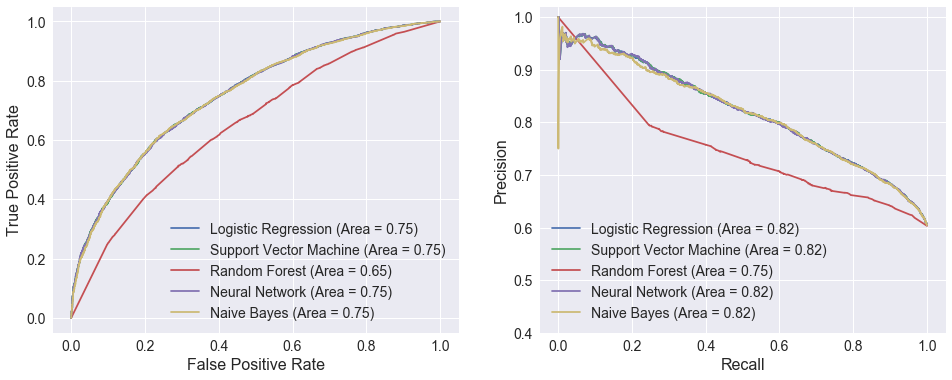Model Performance
This page was created from a Jupyter notebook. The original notebook can be found here. It compares model performance using various algorithms. First we must import the necessary installed modules.
import itertools
import pickle
import numpy as np
import matplotlib.pyplot as plt
import seaborn as sns
from collections import OrderedDict
from sklearn.metrics import accuracy_score, confusion_matrix, classification_report
from sklearn.metrics import roc_curve, roc_auc_score, precision_recall_curve, average_precision_score
from sklearn.linear_model import LogisticRegression
from sklearn.svm import LinearSVC
from sklearn.ensemble import RandomForestClassifier
from sklearn.neural_network import MLPClassifier
from sklearn.naive_bayes import GaussianNB
from sklearn.calibration import CalibratedClassifierCV
The code below simply customizes font sizes for all the plots that follow.
plt.rc('font', size=14) # controls default text sizes
plt.rc('axes', titlesize=16) # fontsize of the axes title
plt.rc('axes', labelsize=16) # fontsize of the x and y labels
plt.rc('xtick', labelsize=14) # fontsize of the tick labels
plt.rc('ytick', labelsize=14) # fontsize of the tick labels
plt.rc('legend', fontsize=14) # legend fontsize
We then load the datasets as before.
f = open('databall.pkl')
X, X_train, X_test, y, y_train, y_test = pickle.load(f)
f.close()
The function defined below displays a nicely formatted confusion matrix. It is a slightly modified version of the function found here.
# This function prints and plots the confusion matrix.
def plot_confusion_matrix(cm, classes, title='Confusion Matrix', cmap=plt.cm.Blues):
plt.imshow(cm, interpolation='nearest', cmap=cmap)
plt.title(title)
plt.colorbar()
tick_marks = np.arange(len(classes))
plt.xticks(tick_marks, classes, rotation=45)
plt.yticks(tick_marks, classes)
plt.grid(visible=False)
cm_norm = cm.astype('float') / cm.sum(axis=1)[:, np.newaxis]
thresh = cm.max() / 2
for i, j in itertools.product(range(cm.shape[0]), range(cm.shape[1])):
plt.text(j, i, '%d\n%.2f%%' % (cm[i, j], cm_norm[i, j]*100),
horizontalalignment='center', color='white' if cm[i, j] > thresh else 'black')
plt.tight_layout()
plt.ylabel('True Label')
plt.xlabel('Predicted Label')
plt.show()
Models will be trained with SRS. The OrderedDict is used to store the models to plot performance curves at the end.
models = OrderedDict()
attributes = ['TEAM_SRS','TEAM_SRS_AWAY']
Logistic Regression
Logistic regression correctly predicts about 70% of games. The confusion matrix shows that the model really shines in predicting home wins, where it correctly predicted 81.5% of games in which the home team won. However, it struggles to predict home losses, where it barely manages to get half of the games right. A classification report is printed below the confusion matrix that displays metrics such as precision and recall. All the classifiers use 50% probability as the threshold for switching between classes since this is a binary classification problem.
model = LogisticRegression()
model.fit(X_train[attributes], y_train)
models['Logistic Regression'] = model
pred = model.predict(X_test[attributes])
plot_confusion_matrix(confusion_matrix(y_test, pred), ['Loss', 'Win'])
print '_' * 52
print classification_report(y_test, pred, target_names=['Loss', 'Win'], digits=3)
print 'Correctly predicted %.2f%% of games' % (accuracy_score(y_test, pred) * 100)
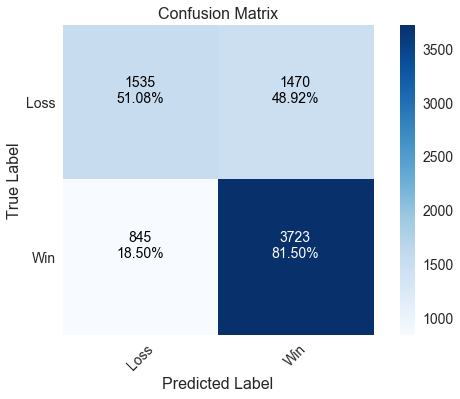
____________________________________________________
precision recall f1-score support
Loss 0.645 0.511 0.570 3005
Win 0.717 0.815 0.763 4568
avg / total 0.688 0.694 0.686 7573
Correctly predicted 69.43% of games
Support Vector Machine
One downside of using LinearSVC over SVC is that LinearSVC does not implement the predict_proba method, which is required to generate ROC and precision/recall curves. We can get around this by passing a trained LinearSVC model to a CalibratedClassifierCV and specifying that the model is “prefit,” meaning no cross validation is to be performed. The model does slightly better with home wins and worse with home losses compared to logistic regression, though the effect is minimal.
model = LinearSVC()
model.fit(X_train[attributes], y_train)
pred = model.predict(X_test[attributes])
model = CalibratedClassifierCV(model, cv='prefit')
model.fit(X_train[attributes], y_train)
models['Support Vector Machine'] = model
plot_confusion_matrix(confusion_matrix(y_test, pred), ['Loss', 'Win'])
print '_' * 52
print classification_report(y_test, pred, target_names=['Loss', 'Win'], digits=3)
print 'Correctly predicted %.2f%% of games' % (accuracy_score(y_test, pred) * 100)
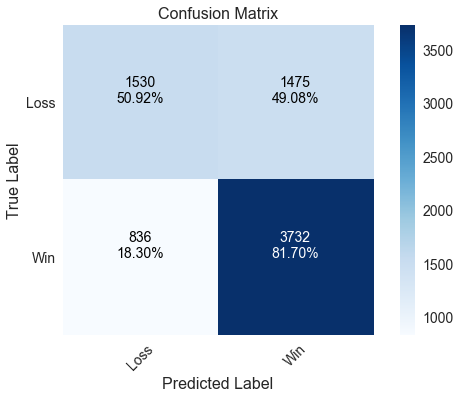
____________________________________________________
precision recall f1-score support
Loss 0.647 0.509 0.570 3005
Win 0.717 0.817 0.764 4568
avg / total 0.689 0.695 0.687 7573
Correctly predicted 69.48% of games
Random Forest
The random forest model does much worse than both the logistic regression and support vector machine models at predicting home wins. It correctly predicted less than 70% of games in which the home team won. It does slightly better than the previous two models at predicting home losses, though the model is less accurate overall by predicting about 62% of games correctly.
model = RandomForestClassifier(n_estimators=10)
model.fit(X_train[attributes], y_train)
models['Random Forest'] = model
pred = model.predict(X_test[attributes])
plot_confusion_matrix(confusion_matrix(y_test, pred), ['Loss', 'Win'])
print '_' * 52
print classification_report(y_test, pred, target_names=['Loss', 'Win'], digits=3)
print 'Correctly predicted %.2f%% of games' % (accuracy_score(y_test, pred) * 100)
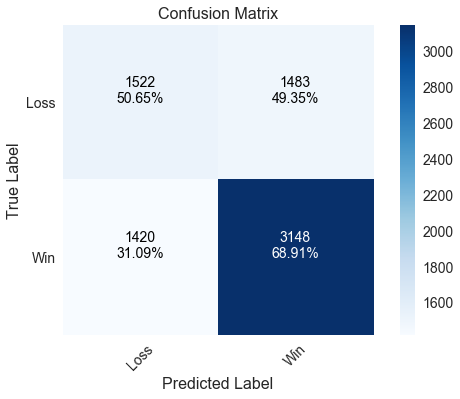
____________________________________________________
precision recall f1-score support
Loss 0.517 0.506 0.512 3005
Win 0.680 0.689 0.684 4568
avg / total 0.615 0.617 0.616 7573
Correctly predicted 61.67% of games
Neural Network
The neural network has similar performance to both the logistic regression and support vector machine models.
model = MLPClassifier(hidden_layer_sizes=5)
model.fit(X_train[attributes], y_train)
models['Neural Network'] = model
pred = model.predict(X_test[attributes])
plot_confusion_matrix(confusion_matrix(y_test, pred), ['Loss', 'Win'])
print '_' * 52
print classification_report(y_test, pred, target_names=['Loss', 'Win'], digits=3)
print 'Correctly predicted %.2f%% of games' % (accuracy_score(y_test, pred) * 100)
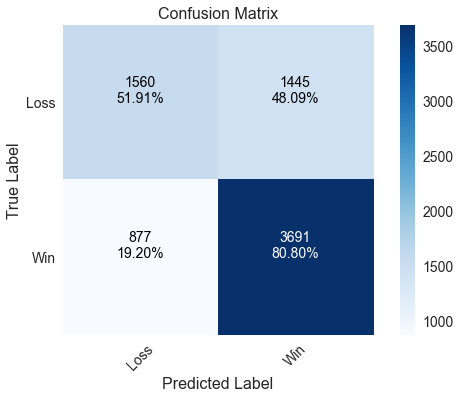
____________________________________________________
precision recall f1-score support
Loss 0.640 0.519 0.573 3005
Win 0.719 0.808 0.761 4568
avg / total 0.687 0.693 0.686 7573
Correctly predicted 69.34% of games
Naïve Bayes
A Naïve Bayes model (implemented with GaussianNB is included as a comparison to the four previous models. It performs the best with home wins by correctly predicting over 82% of those games, but actually performs the worst at predicting home losses where it is no better than a coin flip.
model = GaussianNB()
model.fit(X_train[attributes], y_train)
models['Naive Bayes'] = model
pred = model.predict(X_test[attributes])
plot_confusion_matrix(confusion_matrix(y_test, pred), ['Loss', 'Win'])
print '_' * 52
print classification_report(y_test, pred, target_names=['Loss', 'Win'], digits=3)
print 'Correctly predicted %.2f%% of games' % (accuracy_score(y_test, pred) * 100)
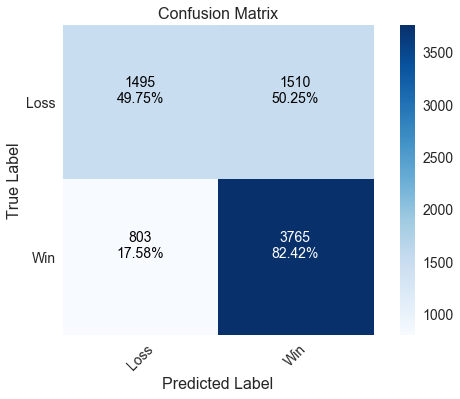
____________________________________________________
precision recall f1-score support
Loss 0.651 0.498 0.564 3005
Win 0.714 0.824 0.765 4568
avg / total 0.689 0.695 0.685 7573
Correctly predicted 69.46% of games
Model Comparison
The following function plots ROC and precision/recall curves similar to the cross_val_curves function from the feature selection page, but does not permit cross validation.
def plot_performance_curves(models, X, y):
plt.figure(figsize=(16, 6))
for label, model in models.items():
prob = model.predict_proba(X)
# Plot ROC curve
ax = plt.subplot(121)
fpr, tpr, thresholds = roc_curve(y, prob[:, 1])
roc_auc = roc_auc_score(y, prob[:, 1])
ax.plot(fpr, tpr, label='%s (Area = %0.2f)' % (label, roc_auc))
# Plot precision/recall curve
ax = plt.subplot(122)
precision, recall, thresholds = precision_recall_curve(y, prob[:, 1])
pr_auc = average_precision_score(y, prob[:, 1])
ax.plot(recall, precision, label='%s (Area = %0.2f)' % (label, pr_auc))
# Label axes and add legend
ax = plt.subplot(121)
ax.set_xlabel('False Positive Rate')
ax.set_ylabel('True Positive Rate')
ax.legend()
ax = plt.subplot(122)
ax.set_xlabel('Recall')
ax.set_ylabel('Precision')
ax.legend()
ax.set_ylim(0.4)
plt.show()
The plots below compare ROC and precision/recall curves for the five models evaluated above. The logistic regression, support vector machine, neural network, and Naïve Bayes curves are nearly identical, which is to be expected given how similar their performance metrics were. The random forest model certainly sticks out with dramatically lower areas under both curves. There is an interesting discontinuity in the precision/recall curve at a recall of around 0.25.
plot_performance_curves(models, X_test[attributes], y_test)
